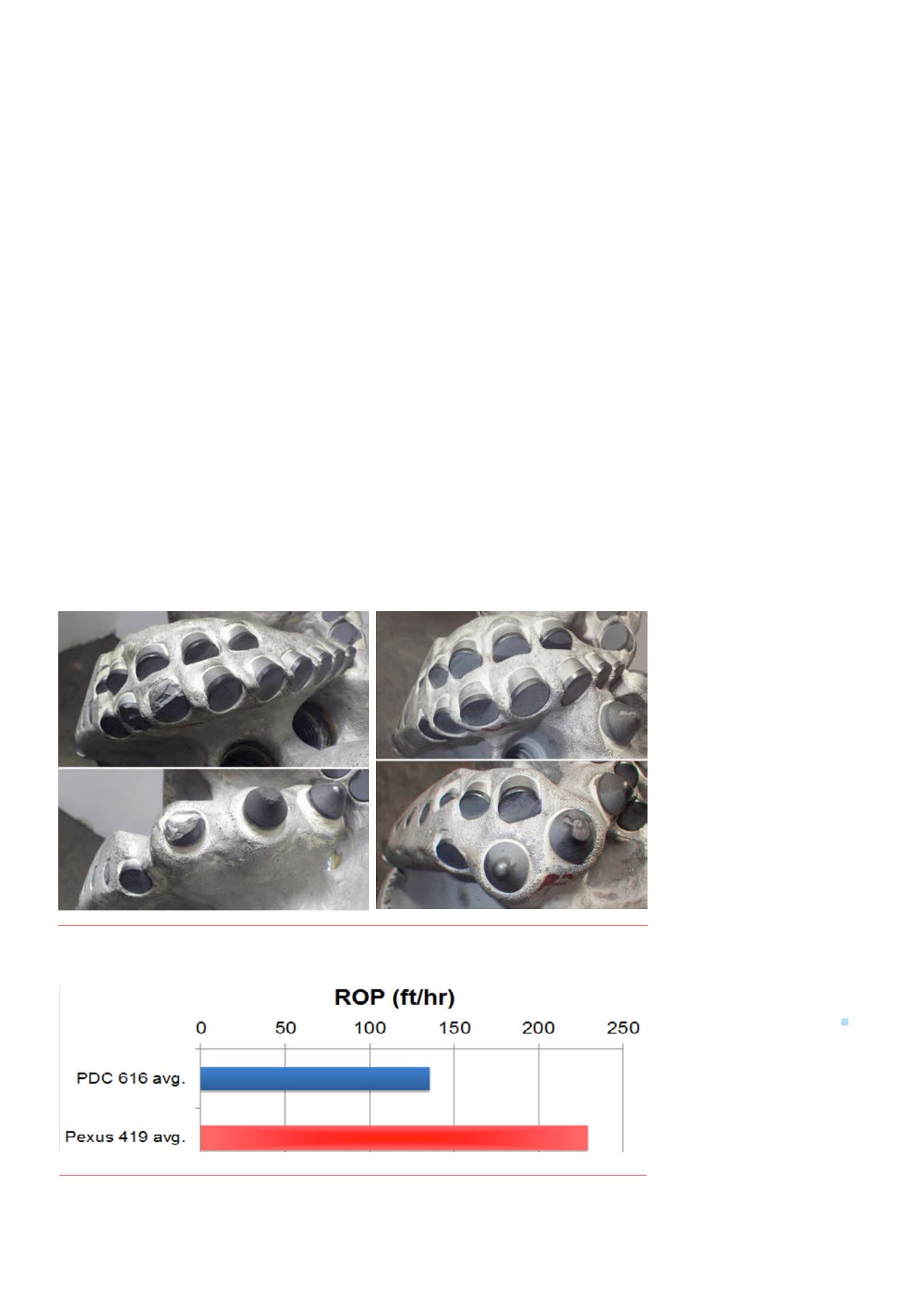
24 |
Oilfield Technology
June
2016
structure (Figure 3). Additionally, to meet the demands of more
main hole applications (typically below 8 ¾ in. diameter), many
of these designs are built using non-rotating diamond gouging
inserts that maximise wear resistance in long and challenging
intervals.
Casestudies
An operator in Western Canada was attempting to drill an
8 ¾ in. diameter interval, reaming a 95 ft long section in
a predominantly hard limestone formation of roughly 20
ksi compressive strength, followed by a 185 ft interval in a
predominantly dolomite formation of comparable strength.
Although short, this interval is very challenging mainly due
to the lithology of both formations – reaming is difficult with
conventional PDC bits, which frequently produce erratic torque
response, poor hole condition and excessive damage on the
gauge area of the bit in similar wells. Instead, 547 or 617 type
carbide insert rollercone bits are generally used, but usually
only ream at a 6 - 10 ft/hr average ROP and are subsequently
tripped out for a PDC bit in the lower section. Using a Generation
3 Pexus hybrid design (Figure 4) enabled the operator to ream
at approximately twice the ROP of a typical rollercone, saving
over 10 hours of operating time, as well as eliminating a trip by
drilling the entire section in a single run.
The dull condition (Figure 5) showed minimal component
damage in the cone and nose of the bit, largely due to the added
protection provided by the hybrid cutting structure. The reaming
portion of the run caused moderate to heavy breakage of the
gouging inserts and some PDC cutters on the outer shoulder and
gage; thus, it was concluded that future designs for main hole
applications could benefit from additional diamond volume and
protection in these areas.
Using the lessons learned from the 8 ¾ in. run, a Generation 3
Pexus design (Figure 4) was provided for a different operator in
Western Canada, drilling a 6 ¼ in. diameter, 1330 ft long build
interval through two formation types both consisting primarily of
siltstones with interbedded shales. In order maximise durability in
an application with high impact, abrasion and thermal demands,
the design featured twice as many blades of PDC cutters on the
outer shoulder and gauge compared to the 8 ¾ in. bit.
The operator commented that the bit provided very
consistent toolface control, even when run with extremely
high weight on bit (up to 40 000 lb) while sliding and when
transitioning from one formation type into the next. As
evidenced by the dull condition (Figure 5), the additional blades
of PDC cutters provided the outer shoulder durability necessary
to complete the interval with only minimal wear on the PDC
cutters and occasional chipping on the gouging inserts.
Generation 3 Pexus designs have also completed over
25 runs in surface applications since late 2015. In one field
area in Western Canada, 12
¼
in. hybrid bits are routinely
outperforming PDC bits in a formation of 4 - 10 ksi compressive
strength containing sand, shale, and some coarse grained
sediments. A search of 11 close offset wells shows that 419 type
Pexus hybrid bits achieved an average ROP increase of 69%
over 616 type PDC bits in run lengths between 1820 and 2020 ft
(Figure 6). The reduced blade
count consistently provides the
added aggressiveness needed
to significantly boost ROP,
without sacrificing toughness or
steerability.
Conclusion
Since the initial design concept,
Pexus hybrid drill bit technology
has taken significant strides
in its development. Three
generations of design iterations
have continuously strived for
improvement, consistently
achieving positive results
over hundreds of runs in a
wide variety of applications.
The hybrid gouging/shearing
cutting structure is engineered
to provide superior rock
fracturing capability, protection,
and directional control over
conventional drill bit designs.
References
1. Beaton, T., ‘A Hybrid Solution’, Oilfield
Technology, (November, 2014), pp.
45 - 49.
2. Beaton, T., ‘Getting Ahead with
Hybrids’, Oilfield Technology, (June,
2015), pp. 51 - 54.
3. Cookson, C., ‘New Drill Bits Boost
Efficiency, Safety’, The American
Oil & Gas Reporter, (April, 2016),
pp. 80 - 87.
Figure 6.
Average ROP comparison of 11 close offset 12
¼
in. diameter intervals.
Figure 5.
Dull condition of a 8¾ in. Pexus hybridbit after completinga challenging reamingand vertical section
(left). Dull condition of a 6¼ in. Pexus hybriddirectional bit after completinga challengingbuild section (right).


